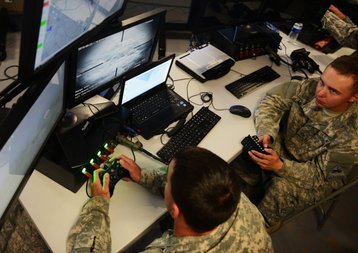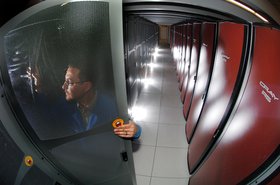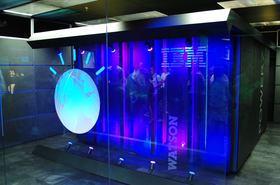Earlier this week, US President Donald Trump signed an executive order promoting artificial intelligence research.
The move follows warnings from Washington about the rapid progress of China's state-funded AI efforts, at a time of growing tensions between the two nations.
Government & AI
The history of computing and artificial intelligence has always been intrinsically linked to government spending and strategy - people often cite state funding that helped create the Internet, but more attention should be given to the fact that the first computers, most supercomputers, internal components such as RAM, and more, were all originally built on the government's dime.
In a similar manner, countless artificial intelligence advancements can be traced back to government support - Apple's Siri, for example, was a spin-off from the Defense Advanced Research Projects Agency's CALO project.
Named after the Latin word for soldier’s servant, CALO aimed to build a cognitive assistant for the US Army. The work of more than 300 researchers over five years was unable to produce battle-ready technology, but even in failure, its spin-offs have gone to influence the wider AI market.
CALO is just one of the many government-led projects that helped build the trappings of modern life, and it is through this lens we should analyze the state-funded initiatives of today.
America, first
On Monday, President Trump signed the Executive Order on Maintaining American Leadership in Artificial Intelligence (viewable here), providing some insight into this administration's AI strategy.
But the order is limited in scope and detail. While it calls on the US companies to “drive technological breakthroughs in AI across the Federal Government, industry, and academia in order to promote scientific discovery, economic competitiveness, and national security,” it also does not seem to include any new funding for such breakthroughs.
Instead, it asks the White House Office of Management and Budget, along with relevant agencies, to prioritize funding for artificial intelligence research. Agencies are told to "promote sustained investment in AI R&D," "enhance access to high-quality and fully traceable Federal data, models, and computing resources," and "train the next generation of American AI researchers and users," but the order provides few details on how to do it.
Some timelines are given - within 90 days of the order, "the OMB Director shall publish a notice in the Federal Register inviting the public to identify additional requests for access or quality improvements for Federal data and models that would improve AI R&D and testing."
But again, actual commitments are limited: "Within 180 days of the date of this order... agencies shall consider methods of improving the quality, usability, and appropriate access to priority data identified by the AI research community."
The document also calls for a "report to the President making recommendations on better enabling the use of cloud computing resources for federally funded AI R&D."
The lack of new funding, or aggressive targets, has been criticized by some. “If we’re serious, we have to pay,” Jim Lewis, SVP and director of the technology policy program at the Center for Strategic and International Studies, told Popular Science.
CSIS is a think tank that in 2017 received 34 percent of its funding from corporate grants, 24 percent from the government, 23 percent from foundation grants and 12 percent from individuals. It styles itself as a bi-partisan organization, and has had a considerable influence on US foreign policy, according to ex-National Security Advisor Tom Donilon, and ex-CIA Director John Brennan.
Lewis added: “It’s good to have a strategy. It would be better if it had some money attached to it, but let’s be a little more confident about how the US will move forward.”
It is also important to note that many of the goals regarding partnerships across academia, industry, and geographic borders, and the concept of improving federal datasets, were all promised when the White House created the National Science and Technology Council Select Committee on Artificial Intelligence back in May 2018.
The NSTC Select Committee will coordinate the execution of the latest executive order, but it is unclear how many new targets and plans are contained within. Other aspects of the order mimic or build upon the National Artificial Intelligence Research and Development Strategic Plan, released in 2016 under the Obama administration.
To be fair to the Trump administration - despite its overall strategy of reducing government spend and agency size - it has kept most of the funding for major future-facing computing initiatives intact.
An AI in every pot
While there were early concerns that the Department of Energy would be essentially de-funded under Trump, supercomputing initiatives have survived such culls - and many proposed cuts were rejected by Congress.
In April 2018, the DOE announced it would spend up to $1.8 billion on “at least two” new exascale supercomputers, and there are plans to procure several smaller AI-focused systems before reaching exascale. It should, however, be noted that the recent government shutdown hampered some of these efforts, with nonprofit the Science Coalition estimating it put at least $1.3bn in fundamental science research funding on hold.
Late last year also saw the passage of the National Quantum Initiative Act, which promised $1.2 billion in quantum research funding over 10 years across the Department of Energy, the National Institute of Standards and Technology, NASA, and the National Science Foundation.
The NSF is home to numerous AI projects, and is "investing over $100 million annually to support AI research," the organization said in May 2018. This year, it promised to spread $300m equally across 10 'Big Ideas,' two of which have a strong AI focus - Harnessing the Data Revolution (HDR), and The Future of Work at the Human-Technology Frontier (FW-HTF).
Also of note is the foundation's work with the 'Partnership on AI' group (whose founding members are Amazon, Facebook, Google, DeepMind, Microsoft and IBM). Back in November, NSF and PAI announced "a joint $4.5 million funding pool for high-risk, high-reward research at the intersection of the social and technical dimensions of AI."
PAI said at the time: "This funding opportunity will support EArly-concept Grants for Exploratory Research (EAGERs) to understand the social challenges arising from AI technology and enable scientific contributions to overcome them. The NSF EAGER funding mechanism is used to support exploratory work in its early stages on untested, but potentially transformative, research ideas or approaches."
The US government's numerous civilian bodies - from the National Institutes of Health, to the Bureau of Labor Statistics, to NASA - are running hundreds of AI groups and funding efforts. Some are huge, like project CANDLE, the initiative between DOE, NIH and National Cancer Institute that hopes to cure cancer with machine learning and supercomputers. Others are smaller and more gimmicky, like Cimon, the head-shaped IBM Watson-speaking, Airbus-developed AI system that floats around the International Space Station.
A few of these projects are then coordinated under the Networking and Information Technology Research and Development (NITRD) Program, which "is the principal means by which the Executive Branch coordinates science and technology policy across the diverse entities that make up the Federal research and development enterprise."
Across all agencies, the US Government’s investment in unclassified R&D in AI-related technologies stood at approximately $1.1 billion in 2015, according to the National Science and Technology Council Subcommittee on Machine Learning and Artificial Intelligence.
Military matters
The Department of Defense, meanwhile, continues to see its funding growing - with more and more of the money focused on AI. Back in May, then-Defense Secretary Jim Mattis sent Trump a memo asking for a national strategy on artificial intelligence. In June, the Pentagon formed the Joint Artificial Intelligence Center, or JAIC, which, the New York Times reports, will have a total of $1.7 billion to spend over five years.
Last week, DCD looked at JAIC, and the $10bn JEDI cloud super-contract, to understand the DoD's approach to cloud computing and AI. Both JAIC and JEDI seek deep partnerships with large corporations, a move welcomed by senior figures at Amazon and Microsoft - but protested by their employees. Google, which secretly worked on Project Maven (an effort to improve image recognition on military drones), faced such a vociferous internal backlash, it pulled out of military contracts entirely.
Elsewhere in the sprawling organizational chart of the DoD is the Defense Information Systems Agency, which is also funding AI projects, with an eye to working with JAIC once the project is fully established. "AI is a force multiplier and agent of transformation across all DoD functions – we will harness it smartly and at pace," DoD CIO Dana Deasy wrote in a 'DISA Forecast to Industry' presentation last November.
Then, there's DARPA, which requested $3.17bn budget in 2018, and $3.44bn in 2019. Highlighting the importance of AI research to the agency, DARPA in September announced $2bn in new and existing AI programs, calling the campaign “AI Next.”
AI Next focuses on what DARPA identifies as the 'Third Wave of AI' - the first was rule-based systems capable of narrowly defined tasks, the second - machine learning technologies "that created statistical pattern recognizers from large amounts of data."
The third "seeks to explore new theories and applications that could make it possible for machines to adapt to changing situations," with limited data.
Agency's director, Dr Steven Walker, talked abut the program at DARPA’s D60 Symposium: “With AI Next, we are making multiple research investments aimed at transforming computers from specialized tools to partners in problem-solving. Today, machines lack contextual reasoning capabilities, and their training must cover every eventuality, which is not only costly, but ultimately impossible. We want to explore how machines can acquire human-like communication and reasoning capabilities, with the ability to recognize new situations and environments and adapt to them.”
DARPA said it is pursuing more than 20 programs that are exploring ways to advance the state-of-the-art in AI, and more than 60 active programs are applying AI in some capacity, including the ambitious Electronics Resurgence Initiative, which "aims to more constructively enmesh the technology needs and capabilities of the defense enterprise with the commercial and manufacturing realities of the electronics industry."
In addition, there's DARPA’s Artificial Intelligence Exploration (AIE) program, launched in July 2018 to fund high-risk, fast turnaround third-wave AI projects.
One presolicitation notice for an AIE project, posted in January, "is soliciting proposals to establish the proof of concept prototype for third-wave artificial intelligence methods that could improve and expand the application space of next-generation neurotechnology."
Central Artificial Intelligence Agency
Outside of the umbrella of the military-industrial projects, AI research is of great interest to the surveillance state.
Speaking at the Accelerated AI: Shaping the Future of Government with Artificial Intelligence conference in Washington last November, director of research at the National Security Agency, Dr Deborah Frincke, said AI was becoming indispensable to human analysts. AI systems are increasingly used to sift through the mass of data sucked up by surveillance programs, in an effort to find actionable trends.
Unsurprisingly, many of the NSA's AI efforts are kept classified, but some information can be obtained from studying the wider AI strategy as defined by the Director of National Intelligence, who serves as the head of the sixteen-member US Intelligence Community.
Under its current director, Dan Coats, the DNI has recently announced the AIM initiative. "The Augmenting Intelligence using Machines (AIM) Strategy provides the framework for the incorporation of AIM technologies to accelerate mission capability development across the IC," he wrote in a strategy document.
Coats added that the Intelligence Community "will achieve superiority by adopting the best available commercial AI applications and combining them with IC-unique algorithms and data holdings to augment the reasoning capabilities of our analysts."
Among its objectives, a plan to rapidly transition to "the best available commercial and open source Narrow AI capabilities," as well as develop new AI solutions, and identify "adversarial uses of AI."
Further AI funding can be found at the CIA, which - among other projects - operates In-Q-Tel, a tech venture capital firm. Much of its portfolio of investments (228 are publicly available) involve AI and computing companies, including Algorithmia, Mythic and D-Wave.
Another In-Q-Tel funding recipient is Palantir, which markets itself as a Silicon Valley company for the Intelligence Community. The Wall Street Journal reported earlier this month that in 2018, Palantir brought in roughly $880 million in revenue from government and corporate contracts, but still did not make a profit - providing some clues to its operational costs.
And still, most of the country's AI funding is provided by corporate America. "US Government (USG) investment in AI is dwarfed by investment of the private sector," the AIM Initiative document stated. Among the leaders in this field are the businesses you would expect - Amazon, Microsoft, Google/Alphabet, IBM, Intel and Nvidia. Startups abound, too, with billions pumped into small AI companies every year.
Funding and focus, however, is primarily spent on near-term AI solutions. Most of Google's money, for example, goes not to moonshots, DeepMind or Google Brain, but to incremental improvements in existing products with clear revenue streams.
In 1995, the National Research Council’s (NRC’s) Computer Science and Telecommunications Board (CSTB) produced the report 'Evolving the High Performance Computing and Communications Initiative to Support the Nation’s Information Infrastructure,' a study which was updated in 2002 and 2003.
It "dispelled the assumption that the commercially successful IT industry is self-sufficient, underscoring how much industry instead builds on government-funded university research, sometimes through long incubation periods of years and even decades. It also compellingly illustrates the complex nature of research in the field and the interdependencies between various subfields of computing and communications research," the National Research Council said.
Building the future of artificial intelligence requires basic research across hardware and software - a willingness to fund something like CALO for years, with only a small chance of seeing returns.
It is here that the government strategies are vital, with state funds allowing for long-term national interest projects. This is where a top-down national plan is crucial - bringing the disparate AI programs across the US government's agencies together, and providing funding to the academia and industry for high risk projects that take decades to pay off, if at all.
“The administration’s American AI Initiative includes all of the right elements; the critical test will be to see if they follow through in a vigorous manner," Professor Jason Furman, who served as chairman of President Obama's Council of Economic Advisers and helped write its 2016 report on artificial intelligence, told MIT's Technology Review.
“The plan is aspirational with no details and is not self-executing.”
For more content like this, be sure to subscribe to our daily newsletter:











